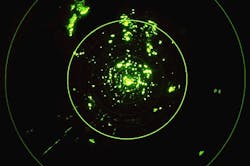Wide available bandwidths at W-band frequencies from 75 to 110 GHz have long made that frequency range attractive for applications from communications through radar. Practical antennas are an important part of making use of those bandwidths, and a substrate-integrated-cavity (SIC) antenna array excited by an L-probe offers high gain with high efficiency at those frequencies.
Developed by researchers at the Nanjing University of Science and Technology (Nanjing, China) and Su Zhou Bohai Microsystem Co. Ltd. (Suzhou, China), the antenna is fabricated on low-temperature-cofired-ceramic (LTCC) substrate material well suited for integration with compact millimeter-wave circuits. The LTCC substrate has a dielectric constant of 6.0 with low loss tangent.
The 8 × 8 SIC antenna array features an LTCC-based ridge-gap waveguide (GWG) feed structure and rectangular-waveguide/GWG transition. By designing the antenna array on multilayer LTCC technology, it was fabricated as a three-dimensional vertical structure in a compact configuration. Using a total of 13 layers of an LTCC substrate, the antenna array circuitry includes the antenna array plane, the SIW feed network, the GWG feed network, and the rectangular-waveguide-GWG transition.
When analyzed with a commercial VNA, a prototype design achieved an impedance bandwidth of 14.9% from 87 to 101 GHz with as much as 23.8 dBi gain and measured aperture efficiency of 42.3%. The high-gain antenna design with its low-loss LTCC structure offers great promise for realizing practical-band solutions. See “High-Gain L-Probe Excited Substrate Integrated Cavity Antenna Array with LTCC-Based Gap Waveguide Feeding Network for W-Band Applications,” IEEE Transactions on Antennas and Propagation, December 2015, p. 5,465.
About the Author
Jack Browne
Technical Contributor
Jack Browne, Technical Contributor, has worked in technical publishing for over 30 years. He managed the content and production of three technical journals while at the American Institute of Physics, including Medical Physics and the Journal of Vacuum Science & Technology. He has been a Publisher and Editor for Penton Media, started the firm’s Wireless Symposium & Exhibition trade show in 1993, and currently serves as Technical Contributor for that company's Microwaves & RF magazine. Browne, who holds a BS in Mathematics from City College of New York and BA degrees in English and Philosophy from Fordham University, is a member of the IEEE.
